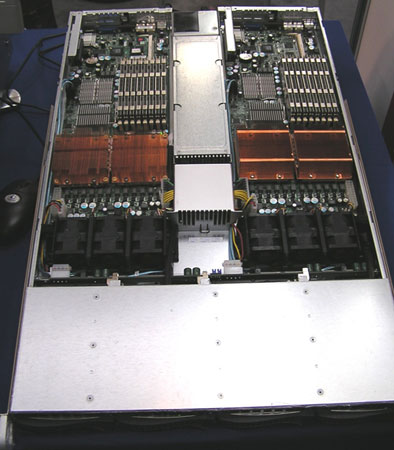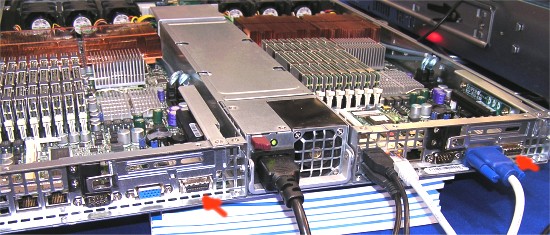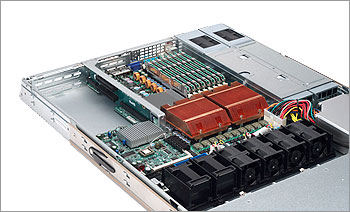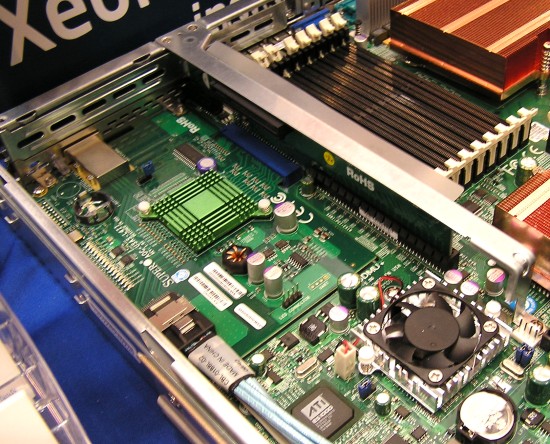CeBIT 2007: Storage & Servers
by Johan De Gelas on March 29, 2007 12:15 AM EST- Posted in
- Trade Shows
Supermicro
Supermicro also decided to offer more HPC specific products, and launched their 1U Twin server.

The 1U Twin offers two nodes, and up to 16 cores (2 nodes x 2 quad cores) in a 1U server, an amazing combination for the people whose prime concerns are density and HPC processing power. The 1U twin is more than just two nodes in one 1U server; this machine has been well thought out. By powering both nodes from the same 980W "up to 91% efficient" power supply, chances are good that the PSU is working at a load where it is close to its maximum efficiency. Of course, this also means that the PSU is a single point of failure, and this might lower the attractiveness as a high availability dual node server. The HPC people will probably not really care as the Supermicro PSUs are known to be very reliable, so the high processing power density and relatively low energy cost might easily offset this disadvantage.

Both nodes can also be "chained" together by the low latency, high bandwidth (20 Gbps) InfiniBand ports.
Several Supermicro Servers also now feature a new proprietary interface, based on PCIe, which Supermicro calls "Universal I/O". It looks like a rectangle part of the motherboard is missing.

At first, another proprietary I/O interface looks like a bad idea. However, Universal I/O was made to protect the investment of the resellers.

For example, consider the situation where a certain generation of SAS controllers is going to be replaced with a faster and cheaper alternative. In that case several barebones in stock might lose quite a bit of their value as customers will prefer the new barebones with the new SAS controller. It is also hard for a reseller to know whether they should stock barebones with high or low end SAS controllers, what percentage of barebones should have mostly PCIe or PCI-X slots, and so on. This is where the Universal I/O board comes in: a barebones server is not as quickly outdated if you simply add the required I/O controller when the server is sold. The Universal I/O boards are made like a part of the motherboard and as such the system does not lose the one or two PCI-E and PCI-X slots for other expansion cards.
Supermicro also decided to offer more HPC specific products, and launched their 1U Twin server.

The 1U Twin offers two nodes, and up to 16 cores (2 nodes x 2 quad cores) in a 1U server, an amazing combination for the people whose prime concerns are density and HPC processing power. The 1U twin is more than just two nodes in one 1U server; this machine has been well thought out. By powering both nodes from the same 980W "up to 91% efficient" power supply, chances are good that the PSU is working at a load where it is close to its maximum efficiency. Of course, this also means that the PSU is a single point of failure, and this might lower the attractiveness as a high availability dual node server. The HPC people will probably not really care as the Supermicro PSUs are known to be very reliable, so the high processing power density and relatively low energy cost might easily offset this disadvantage.

Both nodes can also be "chained" together by the low latency, high bandwidth (20 Gbps) InfiniBand ports.
Several Supermicro Servers also now feature a new proprietary interface, based on PCIe, which Supermicro calls "Universal I/O". It looks like a rectangle part of the motherboard is missing.

At first, another proprietary I/O interface looks like a bad idea. However, Universal I/O was made to protect the investment of the resellers.

For example, consider the situation where a certain generation of SAS controllers is going to be replaced with a faster and cheaper alternative. In that case several barebones in stock might lose quite a bit of their value as customers will prefer the new barebones with the new SAS controller. It is also hard for a reseller to know whether they should stock barebones with high or low end SAS controllers, what percentage of barebones should have mostly PCIe or PCI-X slots, and so on. This is where the Universal I/O board comes in: a barebones server is not as quickly outdated if you simply add the required I/O controller when the server is sold. The Universal I/O boards are made like a part of the motherboard and as such the system does not lose the one or two PCI-E and PCI-X slots for other expansion cards.










13 Comments
View All Comments
BikeDude - Tuesday, April 10, 2007 - link
I've tried to use SuperMicro's management software in the past and quite frankly it is pure and utter c---.Last week I tried HP's management software, and could install the entire OS from a remote location. I could map a .iso image to the blade in question and it booted right up.
OTOH, as I recall, SuperMicro's remote desktop solution is based on VNC. Where HP lets you remotely access the console from before POST is even run, SuperMicro forces you to first install the OS.
(We have lots of Tyan and SuperMicro servers, but of course we might've missed something fundamental along the way -- but... HP has a very nice package once the hardware has been hooked up to the power outlet and your network switch)
Xenoterranos - Friday, March 30, 2007 - link
"Enermax showed how much hardware its Galaxy 1000W can power. According to Enermax, the PSU delivered 933 W to 24 80GB hard disks, four Opteron 8212 CPUs, four 3Ware 9650 drive controllers, a GeForce 7600GX and 8GB of RAM (16 x 512MB)."...or 2 GeForce 8800's.
yyrkoon - Friday, March 30, 2007 - link
So now we 'need' usb ports on the front of a rack mount server ?! I'd rather have onboard SAS to be honest ;)
Interresting toys, no doubt.
JohanAnandtech - Friday, March 30, 2007 - link
Well, I find sometimes very handy for installing quickly a driver or a small testprogram etc. Or in some cases to add a USB CDROM, or to make a quick backup on a USB harddisk.Do you feel that USB has no use on the front of a server?
neogodless - Thursday, March 29, 2007 - link
I've heard of Home Theatre PC (HTPC) but HPC... is...?laok - Thursday, March 29, 2007 - link
High Performance ComputingDesslok - Thursday, March 29, 2007 - link
Tyan should have taken the silica bag off that system before showing it off.AnandThenMan - Thursday, March 29, 2007 - link
Hellz no! The silica bag and the inanimate carbon rod are the main reasons people flock to these shows.ravedave - Thursday, March 29, 2007 - link
So the Barcelona is no longer known as the K8L and is now again being called the K10? When is the launch for this part? Last I saw it was Q1, which is almost over...JohanAnandtech - Thursday, March 29, 2007 - link
AFAIK, the K8L name was never used by AMD: it was invented on the Internet. THe K10 will be launched mid 2007 (that is all AMD says), probably the Summer of 2007